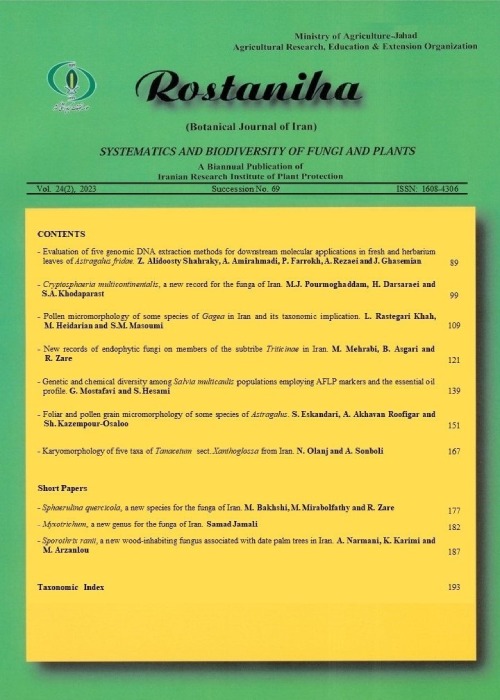Solanum viarum (Solanaceae), a new invasive plant for Iran
Author(s):
Article Type:
Research/Original Article (دارای رتبه معتبر)
Abstract:
In recent field studies, Solanum viarum Dunal(Solanaceae) was collected and reported for the first time for the flora of Iran from around Qadikola in Mazandaran province (north of Iran). Notes on the morphology, taxonomy, geographical distribution, habitat and uses of this species are provided herewith. This is the first spiny species of the section Acanthophora in Iran. Solanum viarum Dunal in DC., Prodromus systematis naturalis regni vegetabilis 13(1): 240 (1852); Type: Sao Paulo. Brazil, Lund 799 (GDC. holo. IDC microf. 2080: 1.1). Plants mostly shrubs, 1–2 m tall, many-branched from the base; stems, petioles, pedicels, and leaves densely glandular puberulent, straight covered with hairs, hairs less than 0.5 mm long; stem with few prickles, stems and leaves with yellow spines up to 1.5 cm long; leaves simple, 7–14 cm long and 5–10 cm wide, margins lobed, usually with 3–5 pairs of shallow obtuse or acute lobes; petioles 3–9 cm long, with long prickles; inflorescence lateral, with 2–5 flowers; peduncles stout, 15–20 mm long; calyx pubescent on outside, 4–7 mm long; corolla white or greenish white, star-shaped with five petals, 15–25 mm diameter; fruits globose berry, up to 15–30 cm in diameter, light green mottled, dark green when immature, yellow at maturity, with a whitish or greenish layer; seeds 100–300 per berry, broad kidney-shaped, 2–3 mm in diameter, light red-brown (Fig. 1). The plant was identified and described by the help of studying the reliable flora and articles (Mullahey et al. 1993, Welman 2003, Waggy 2009). Specimen examined: Iran: Mazandaran province, 8 km south of Ghaemshahr, Qadikola forest, 100 m, Eskandari & Abdi (IRAN-77431). According to the Flora Iranica (Schoenbeck-Temesy 1972), 12 species, and Khatamsaz (1998), 10 species of Solanum are reported from Iran but based on a recent taxonomical and molecular study of Solanum (Eskandari et al. 2020), only eight valid species is reported for this genus from Iran. In general, accurate determination of the genera and species in the family Solanaceae in Iran, requires attention by performing more molecular study to clarify its actual taxonomic status (Ghahremaninejad & Riahi 2020). Solanum viarum grows originally in southern Brazil, Paraguay, Uruguay, and northern Argentina, but has also spread in South America, Central America, the West Indies, and the southern United States (tropical soda apple). This plant has long been naturalized in part of China and the Indian subcontinent (Babu 1971), and is reported in the Democratic Republic of the Congo and Cameroon (Jaeger & Hepper 1986) also. The species was accidentally and sporadically introduced into Africa and can be expected to spread to many other subtropical areas (Nee 1991), but recently becoming an invasive species in cattle pastures in the south-eastern United States. Since its introduction into the U.S., it has rapidly infesting to an estimation of one million acres of pastures, citrus groves, sugarcane fields, ditches, vegetable crops, forestlands (oak hammocks and cypress heads), natural areas etc. (Charles et al. 2012). In more tropical areas, flowering and fruiting occurs throughout the year (Nee 1991) while in open woodland and pine plantations of southern Africa, flowering season is confined to November to April with fruiting in August (Welman 2003). The root system of this plant consists of a deep and strong wooden base with numerous resistant lateral branches which under suitable conditions (low elevations mostly below 1000 m), can become invasive with a wide range of distribution. It is often a common weed of natural areas, improved pastures, croplands, roadsides and fence rows, waste places, open disturbed sites, secondary growth and forest edges (Waggy 2009). Solanum viarum contains chemical constituents like Solasodine which is found in many plants of Solanaceae family. The Solasodine has many medicinal properties and are used as fever-reducing agent, pain-reliever, laxative, diarrhea, anticoagulant and anti-asthma, anemia, burns, carminative, constipation, cough, cut restoration, food digestion, infections, mouth disinfection, skin diseases, toothache etc. in Iran. (Eskandari et al. 2019).
Language:
English
Published:
Botanical Journal of Iran, Volume:21 Issue: 2, 2021
Pages:
299 to 302
magiran.com/p2221124
دانلود و مطالعه متن این مقاله با یکی از روشهای زیر امکان پذیر است:
اشتراک شخصی
با عضویت و پرداخت آنلاین حق اشتراک یکساله به مبلغ 1,390,000ريال میتوانید 70 عنوان مطلب دانلود کنید!
اشتراک سازمانی
به کتابخانه دانشگاه یا محل کار خود پیشنهاد کنید تا اشتراک سازمانی این پایگاه را برای دسترسی نامحدود همه کاربران به متن مطالب تهیه نمایند!
توجه!
- حق عضویت دریافتی صرف حمایت از نشریات عضو و نگهداری، تکمیل و توسعه مگیران میشود.
- پرداخت حق اشتراک و دانلود مقالات اجازه بازنشر آن در سایر رسانههای چاپی و دیجیتال را به کاربر نمیدهد.
In order to view content subscription is required
Personal subscription
Subscribe magiran.com for 70 € euros via PayPal and download 70 articles during a year.
Organization subscription
Please contact us to subscribe your university or library for unlimited access!



